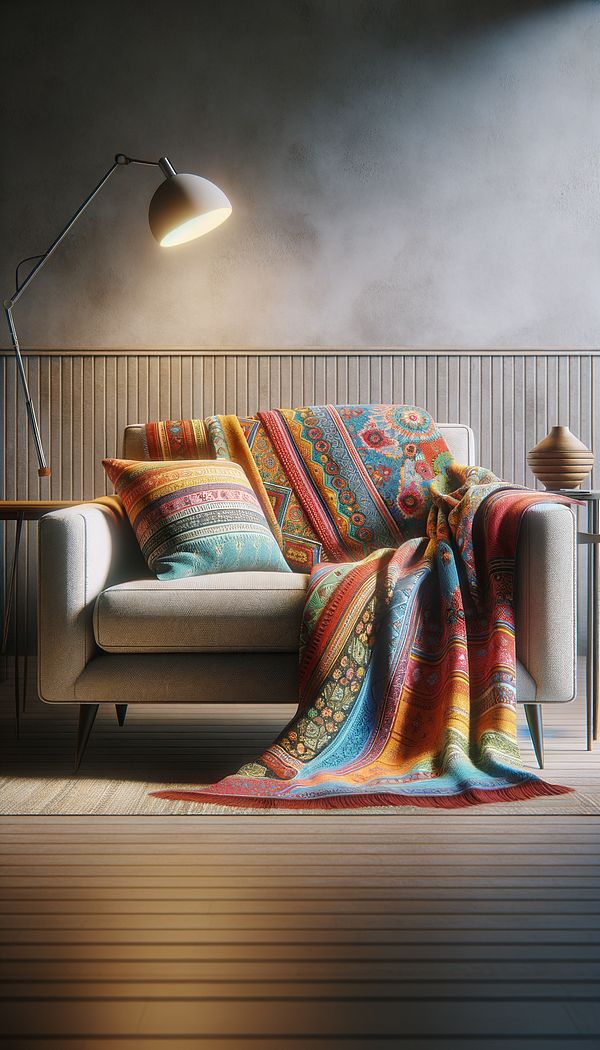What is a Blanket?
A large, rectangular piece of soft fabric, often used for warmth while sleeping or resting.
Description
In the context of interior design, a blanket is not just a utilitarian item for warmth; it's a piece of textile art that adds texture, color, and pattern to a room. Blankets can be made from a variety of materials including cotton, wool, fleece, or even luxurious options like cashmere or alpaca. The choice of material can affect the blanket's warmth, texture, and overall feel, making it an important consideration in the design process.
Blankets often serve dual purposes in interior design. Primarily, they provide comfort and warmth, making a space feel more inviting and cozy. But beyond their functional role, blankets are also key decorative elements. They can add a splash of color to a neutral room, serve as a focal point when draped over a sofa or chair, or introduce new textures and patterns that complement the room's existing decor. In addition, blankets can be easily swapped out according to season or decorating style, making them versatile tools in the interior designer's toolkit.
Choosing the right blanket involves considering the room's color scheme, texture combinations, and the intended use of the blanket, whether purely decorative, functional, or a mix of both. For example, a chunky knit blanket might add a cozy, tactile element to a minimalist room, while a finely woven, patterned throw could add sophistication to a more classic decor.
Usage
In a modern living room, a designer might use a geometric-patterned blanket to add a pop of color and texture against a sleek, monochromatic sofa, enhancing the room’s aesthetic appeal. In a bohemian-styled bedroom, an artisanal, handwoven blanket could be draped across the foot of the bed, adding warmth and a sense of craftsmanship to the space. During the cooler months, heavier, woolen blankets can be layered on beds or sofas to increase warmth and comfort, while lightweight, cotton blankets might be preferred during warmer weather for their breathability and softness.
FAQs
-
How should I choose a blanket for my interior design project?
Consider the room's existing decor, the desired aesthetic effect, and the practical needs for warmth and comfort. Factor in the material, color, pattern, and texture of the blanket to ensure it complements the space effectively.
-
Can a blanket be a statement piece in room decor?
Absolutely. A blanket with a bold pattern, vibrant color, or unique texture can serve as a focal point in a room, drawing the eye and tying together other elements of the decor.
-
Are blankets only suitable for living rooms and bedrooms?
While living rooms and bedrooms are the most common spaces for blankets for their comfort and aesthetic appeal, blankets can also be utilized in outdoor seating areas, home offices, or reading nooks to add warmth and style.
Practical Application
When incorporating a blanket into your interior design, think about layering different textures and colors for added depth. A blanket can be neatly folded at the end of a bed, casually draped over a piece of furniture, or stored in a decorative basket for easy access. Experiment with multiple blankets in varying materials and patterns to achieve the desired look and feel for the space. Consider seasonal swaps to keep the decor fresh and aligned with the changing weather.
-
ChambrayChambray is a lightweight cotton fabric with a plain weave and a slightly glossy surface.
-
Continuous CoilContinuous Coil refers to a engineered construction method used in mattresses and upholstery.
-
ReedingReeding is a decorative technique involving narrow grooves carved into the surface of wood, metal, or stone.
-
TallboyA tallboy is a piece of furniture featuring a chest of drawers often combined with a wardrobe on top.
-
Curio CabinetA curio cabinet is a type of display case made primarily of glass, designed for showcasing collectibles, antiques, and curiosities.
